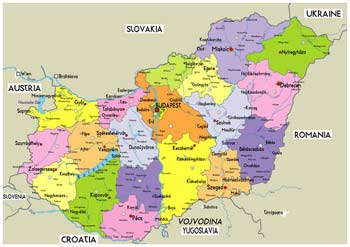 The official language is Hungarian.
The official language is Hungarian.The capital - Budapest.
Parliamentary republic
Currency - Hungarian Forint (Exchange rate: U.S. $ 1 equals approximately 215 forints)
Time lags by 2:00
Voltage - 220 volts. 50 Hz.
The climate is temperate continental with warm features.
The territory of 93 thousand square kilometers and a population of over 10 million people.
Hungary is divided into 19 counties (regions) and the city of republican subordination in Budapest.
The Hungarian People's Republic is located in Central Europe, most of it is on the Middle-plain, north of Lake Balaton Srednevengerskie mountains in the southern part of Mecsek blocky tower height to 681 meters to the north are the spurs of the Western Carpathians and their height up to 1000 m
The largest river in Hungary - the Danube, its length in the country is 420km, others the Tisza River, Slave, Koros, Marusha.
Hungary is located in the heart of Europe and has a special aura that attracts tourists from all over the world. Pompous palaces and imperial architecture, cozy medieval towns and curative thermal baths, fine wines and delicious pastries - it's all here in abundance.
To become better acquainted with this original country, it is recommended to visit the following ten places that allow little imbued with its spirit.
|
|
Central city panorama Zane sen's "World Heritage" by UNESCO: it is building on the waterfront in Budapest, the Citadel on Gellert Hill and Buda Castle, which are one of the most picturesque panoramas in the world.
Flag of Hungary

Virtually the entire territory of Hungary has many historical, cultural and natural monuments of world importance.
- In Hungary, the objects are of universal value worthy of protection as part of World Cultural Heritage:
- - The largest in Central Europe, a system of karst caves
- - The famous Hungarian "Puszta", which attracts crowds of tourists trick riding holidays, traditions and roots of his origins in the distant past;
- - The most representative of the western Eurasian steppe lakes Ferte, which is the largest alkaline (alkaline earth) lake in Europe;
- - Found in the town of Pec ancient Christian necropolis with painted tombs;
- - The current in our days of the 1000 summer Abbey in Pannonhalma;
- - Holloke small village that has preserved to the present device is its medieval, folk architecture and traditions;
- - Tokaj wine region, which has unique geographical and geological conditions;
- - Unique lake of Heviz.
Budapest. Fountain of the Danube. Visegrad. Lake Balaton. Sopron, the old town. Székesfehérvár. Monument to the "Power". Miskolc. Cave baths
Once upon a time the country was the eastern boundary of the Roman Empire, and even before the arrival of Hungarians in the middle reaches of the Danube lived Roman, Germanic and Slavic tribes. On stormy historical events testify and luxurious collections of numerous museums and masterpieces of the exhibition halls, and unique architectural style of the Hungarian cities.
Monuments of the Roman Empire side by side here with buildings era of Turkish rule, Romanesque churches - medieval fortresses. Palaces "framed" picturesque small towns typical of local architecture.





